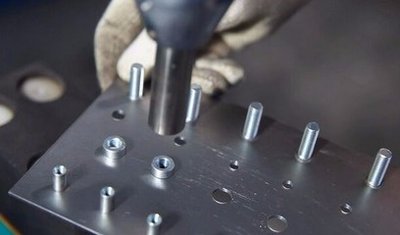There are several ways to create threads in sheet metal parts. Here are three common methods:
1. Rivet Nuts: This method involves the use of rivets or similar fasteners to secure a threaded nut to a sheet metal part. Nuts provide a threaded connection for a bolt or screw. This method is suitable for applications requiring a strong and removable threaded connection.
2. Tapping: Tapping involves using a tap to cut threads directly into sheet metal. This method is suitable for thinner sheet metal and is often used when a permanent threaded connection is required. Tapping can be done using hand tools or machine tools.
3. Extrusion Tapping: Extrusion tapping involves forming threads directly into sheet metal during the manufacturing process. This method creates threads by deforming metal to form threads, without the need for additional hardware such as nuts. Extrusion tapping is a cost-effective method of creating threads in sheet metal parts.
Each method has its own advantages and limitations, and the choice of method depends on factors such as the specific requirements of the application, the material and thickness of the sheet metal, and the required strength and reliability of the threaded connection. It is important to carefully consider these factors when choosing the most appropriate method for creating threads in a sheet metal part.
Extrusion tapped holes are often preferred over rivet nuts when creating threads in sheet metal parts under the following circumstances:
1. Cost: Extrusion tapped holes are more cost effective than rivet nuts because they do not require additional hardware such as nuts and washers.
2. Weight: Rivet nuts add extra weight to the assembly, which may be undesirable in weight-conscious applications. Extruding tapped holes does not add any extra weight.
3. Space Constraints: In applications where space is limited, squeeze tapped holes are more practical because they do not require the additional clearance required for rivet nuts.
4. Strength and Reliability: Compared to rivet nuts, extrusion tapped holes provide safer and more reliable threads because they are integrated directly into the sheet metal part, reducing the risk of loosening or failing over time. risk.
However, when selecting extrusion tapped holes and rivet nuts, it is important to consider the specific requirements of the application, the material and thickness of the sheet metal, and the assembly process. Each method has its own advantages and limitations, so it’s important to evaluate the specific needs of your project before making a decision.
For extrusion tapping holes in sheet metal parts, the material of the sheet metal itself is the primary consideration. Commonly used materials for sheet metal parts include steel, aluminum, stainless steel and various alloys. The specific material chosen will depend on factors such as strength requirements, corrosion resistance and cost.
Rivet nuts are usually made of materials such as steel, stainless steel or aluminum. The choice of rivet nut material depends on factors such as strength required for the application, potential for corrosion, and compatibility with sheet metal materials.
As for thickness limits, both extrusion tapped holes and rivet nuts have practical limits based on sheet metal thickness. Extrusion tapping holes are generally suitable for thinner sheet metal, usually up to around 3mm to 6mm, depending on the specific design and material. Rivet nuts are available in a wide range of thicknesses, usually around 0.5mm to 12mm, depending on the type and design of the rivet nut.
Always consult a mechanical engineer or fastening expert to determine the specific material and thickness considerations appropriate for your application and to ensure that the chosen fastening method meets the required strength and performance standards.HY Metals team will always give you the most professional advice for your sheet metal manufacturing design.
Post time: Mar-13-2024



